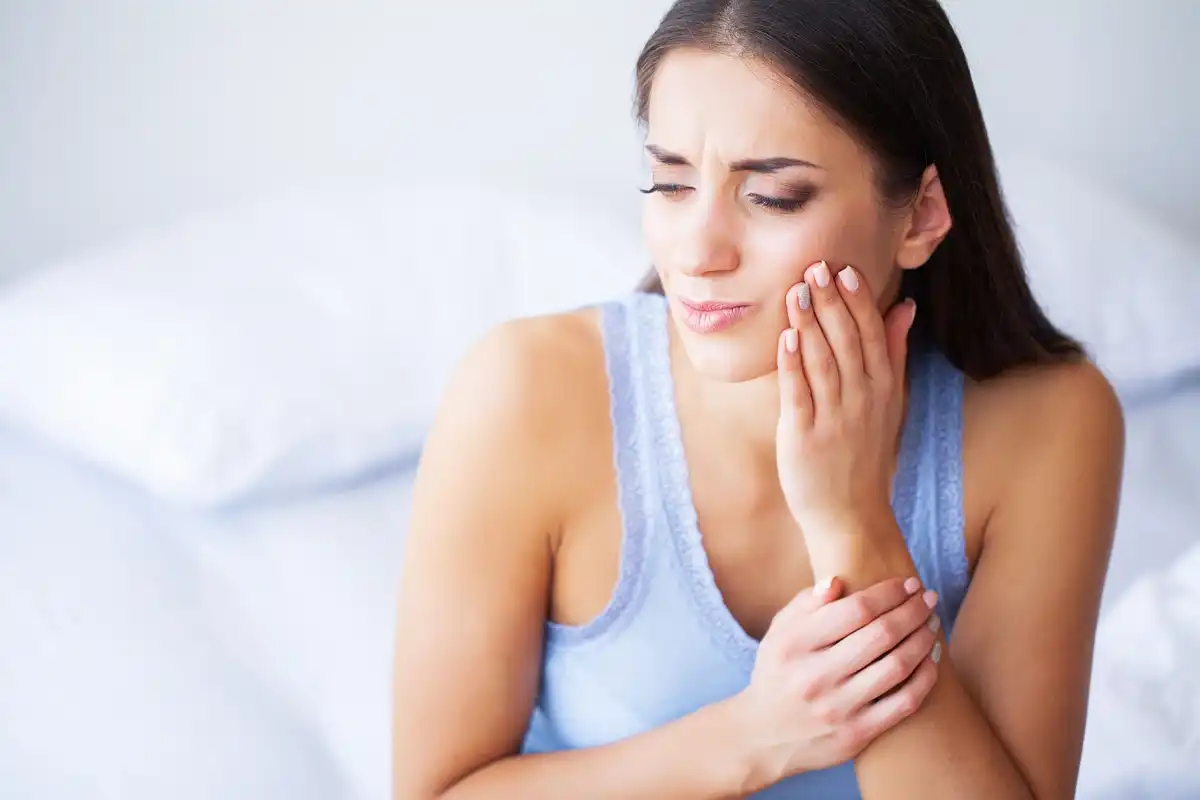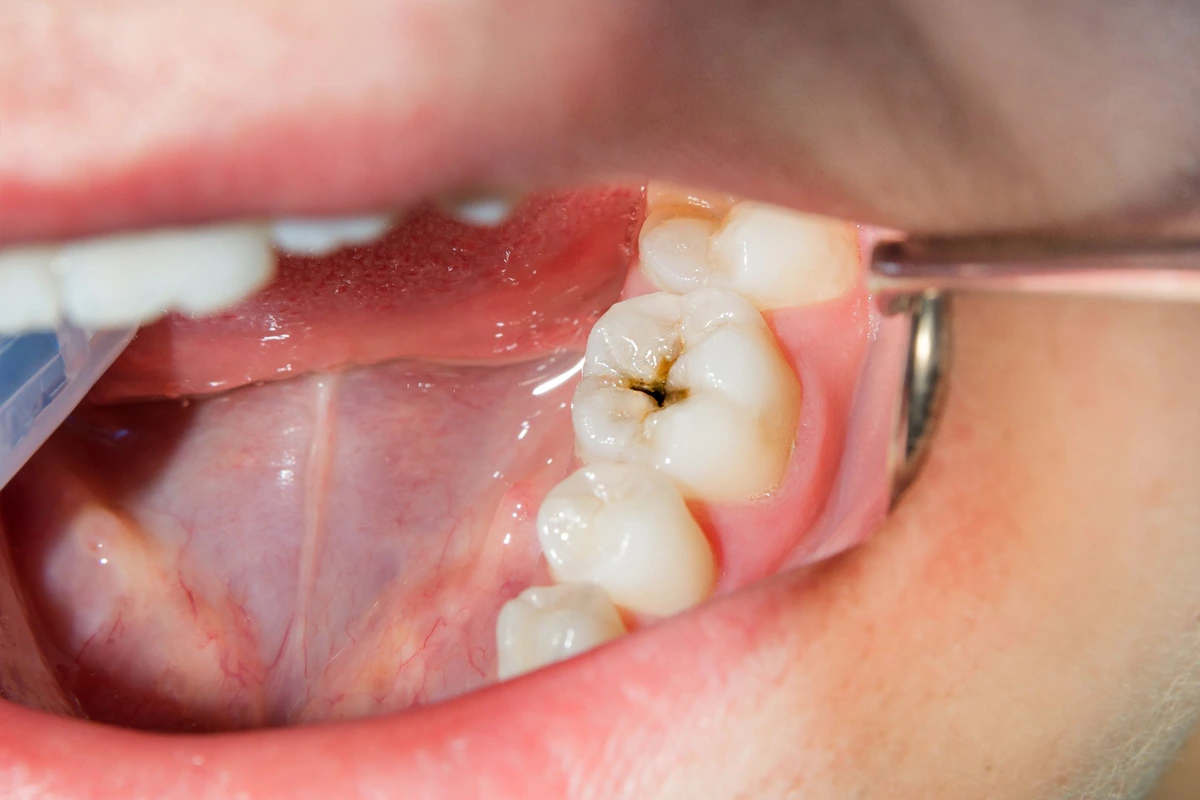7 Reasons Why Your Tooth Hurts When Biting Down or Chewing


One of the most common types of toothaches to have is a sensitivity to tooth pressure when you’re biting or chewing. If your tooth hurts when you bite down, there can be a few reasons for the sharp pain; none of them should be ignored.
You might say “Since my tooth hurts when I put pressure on it, I just don’t bite on it at all.” But when you’re compromising with other teeth to do your biting and chewing, it can lead to secondary issues like TMJ pain or irregular tooth wear.
Instead, it’s best to address the tooth pain once and for all.
Why Does My Teeth Hurt When I Bite Down
Recognizing the various types of tooth sensitivity — in this case, tooth pressure — can help you to differentiate what’s going on inside of your mouth before you pick up the phone to call your dentist.
1) Broken Tooth
Treatment
The only treatment for a cracked tooth is usually a crown (if the crack hasn’t reached the nerve) or a root canal. For severe cracks, it might be best to have the tooth extracted altogether. You can think of cracked teeth like a “run” in a pair of old-fashioned pantyhose. Once it starts, there’s no stopping it.
2) Loose Tooth
When a loose tooth hurts when you bite on it, it’s typically due to those tiny ligaments stretching and pulling. Just like muscles and ligaments elsewhere, loose teeth can become sore. Your tooth might be loose as part of the natural exfoliation (falling out) process – like what we see in kids – or because of an infection such as gum disease. Another possibility is if you get hit in the mouth it could knock your tooth loose or damage the bone around it.
Treatment
Depending on why your tooth is loose, you have a couple of options: extract it or splint the tooth into place. A splint can hold your tooth in place by stabilizing it with adjacent teeth until it “firms back up”. But if stabilization isn’t an option, removing the tooth altogether is typically best.
3) Cavity
Any time you tell your dentist, “my tooth hurts when I put pressure on it,” there will be some detective work to do. Does it only hurt if pressure is applied? Or do you notice the tooth pain getting worse when there are temperature changes? What about sweets, like juice, diet soda, or your coffee creamer? If sweet sensitivity is easy to pick up, then it’s likely that you have a cavity.
Treatment
Treating active tooth decay can only be done properly by having your dentist clean out the damaged tooth structures and filling the void in with a small restoration. Sealing the cavity off will prevent painful stimuli when you’re biting, chewing, or drinking. Today most fillings are made from tooth-colored composite (white) materials, as they’re less invasive to your tooth and more attractive to look at.

4) Loose Filling
Anytime a tooth hurts, we want to take a peek at it to see if you’ve had previous dental work done in that area. Over time it’s common to see fillings start to leak or pull away from the tooth as they age. This situation can create a loose filling that shifts each time you bite down on that tooth. Even if you can’t see a gap (what we call an “open margin”) around your filling doesn’t mean there isn’t a leak.
Treatment
It’s best to have leaky fillings changed out in a timely manner before more bacteria seep underneath and lead to recurring tooth decay. As long as the filling is small, it can be changed out with a new one. But larger fillings may involve so much tooth structure that a full-coverage crown is the best choice.
5) Infection After Root Canal
Let’s say your tooth hurts with pressure applied to it, but you’ve already had endodontic therapy (a root canal). Even though your tooth isn’t “alive” anymore, you’re feeling some painful twinging on that area every time you chew. Although it’s rare, there are some situations where a root canal can fail. When that happens, residual bacteria or nerve tissues close to the tip of the root lead to a recurring infection and tooth pain.
Treatment
Root canal re-treatments are typically referred to an endodontic specialist. Endodontists have special equipment on hand to visualize the inside of your tooth nerve and extra resources to access canals that are already sealed off. Keep in mind that it’s “better” (theoretically) to retreat a root canal tooth than it is to pull it; you need to keep your natural teeth as long as possible!
6) Gum Disease
Let’s go back to those tiny ligaments again. Periodontal disease destroys those attachments between your tooth root and gum tissue. The infection also causes severe swelling, bleeding, gum recession, and exposed tooth roots can occur. You might be saying, “my tooth hurts when I put pressure on it, but my gums have nothing to do with that.” In reality, your gums help hold your teeth in place. If they’re infected or diseased, you may only feel the tooth pain when you’re pressing down on the tooth.
Treatment
Periodontal therapy targets the diseased “pockets” around your teeth, where the bacteria are eating away at your ligaments and bone. Usually, the periodontal disease treatment process involves a series of deep cleanings to remove calcified tartar and plaque buildup down under your gum tissues (where a toothbrush and floss don’t reach.) The ultimate goal is to get those gum tissues to tighten back up and reattach to the tooth, and as a result they shouldn’t feel sore when you’re chewing.
7) A Dental Abscess
Swollen or dying dental nerves usually cause fluid buildup at the tip of the tooth root. You may even see a visible fistula (“pimple”) on the gums, where the infection is draining. Pressing down on the top of your tooth with a dental abscess can make your tooth sore, due to the fluid buildup underneath the root.
Treatment
The best treatment for an abscessed tooth is to clean out the infected nerve, then seal the canal off with a root canal. Endodontic treatment prevents the need for extracting your tooth while also eliminating the source of pain.
Soothing Tooth Pain
When To See A Doctor
Anytime you feel tooth pain associated with tooth pressure, it’s best to go ahead and plan a trip to the dentist’s office. They’ll need to take a dental X-ray to see the areas around the tip of the root to rule out an abscess. Plus, they have special tools to check for leaky fillings or cracked teeth. Pinpointing the main cause will help you treat the issue before it evolves into something more severe. In other words, you could settle for a filling instead of holding out longer and winding up with a root canal.
Overcoming Tooth Pain When You Bite Down
If you’ve said, “my tooth hurts when I put pressure on it” and the tooth pain just isn’t going away, there’s a good reason for it. Whether the tooth is cracked, abscessed, or has gum disease doesn’t matter. What does matters is that you get a professional opinion in the near future. Only then can you prevent the tooth pain from getting worse or having an unwanted emergency pop up! With sharp pain, you’ll never regret not having waited for a dental exam.

Make your inbox smile!
Subscribe






